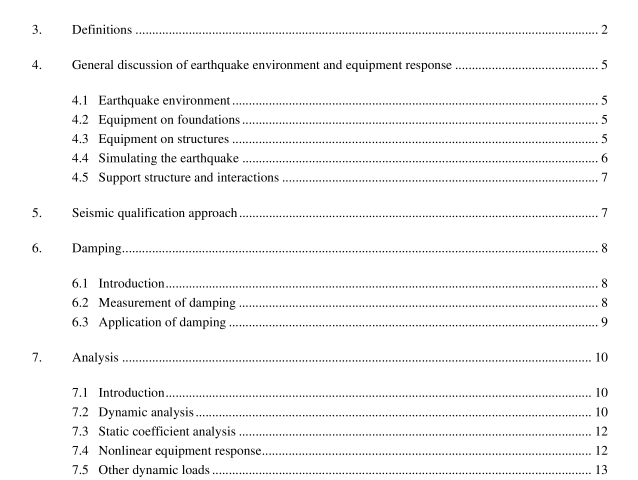IEEE 344-2004 pdf download.IEEE Recommended Practice for Seismic Qualification of Class 1E Equipment for Nuclear Power Generating Stations.
4. General discussion of earthquake environment and equipment response
This clause provides background information on earthquake behavior and on the performance of equipment during simulated seismic events. Numerical values provided are typical and illustrative and should not be considered as standards.
4.1 Earthquake environment
Earthquakes produce three-dimensional (3D) random ground motions that are characterized by simultaneous but statistically independent horizontal and vertical components. The strong motion portion of the earthquake may last from 10 s to 15 s, although the complete event may be considerably longer. The ground motion is typically broadband random and produces potentially damaging effects over a frequency range of 1 Hz to 33 Hz.
4.2 Equipment on foundations
The vibratory nature of the ground motion (both horizontal and vertical) can be amplified or attenuated in foundation-mounted equipment. For any given ground motion, the alteration depends on the system’s natural frequencies of vibration (soil, foundation, and equipment) and the damping mechanisms. The typical broadband response spectra that describe the ground motion indicate that multiple-frequency excitation predominates.
4.3 Equipment on structures
The ground motion (horizontal and vertical) may be filtered by intervening building structures to produce amplified or attenuated narrowband motions within the structure. The dynamic response of equipment on structures may be further amplified or attenuated to an acceleration level many times more or less than that of the maximum ground acceleration, depending upon the equipment damping and natural frequencies. The narrowband response spectra that typically describe a building floor motion indicate that single-frequency excitation of equipment subcomponents can predominate. Similar filtering of in-structure motion may occur in flexible piping systems. For components mounted away from supports, the resultant motion may be predominantly single frequency in nature and centered near or at the resonant frequency of the piping system. This resonance condition may produce the most critical seismic load on components mounted on the line.
4.4 Simulating the earthquake
The goal of seismic simulation is to reproduce the postulated earthquake environment in a realistic manner.
The form of the simulated seismic motion used for the qualification of equipment by analysis or testing can be described by one of the following functions:
a) Response spectrum
b) Time history
c) Power spectral density (PSD)
The simulated seismic motion may be generated for the foundation, floor of the building, or substructure upon which the equipment is to be mounted. It is supplied by the user or the user’s agent as a part of the specifications for that equipment (see Clause 11) or generated by others for generic applications.
Because of the directional nature of seismic motion and the filtered output motion of building and equipment structures, the directional components of the motion and their application to the equipment should be specified or accounted for in some other appropriate manner.
4.4.1 Response spectrum
The response spectrum provides information on the maximum response of single-degree-of-freedom (SDOF) oscillators as a function of oscillator frequency and damping when subjected to an input motion. The frequency content and the peak value of the input motion, that is, the ZPA, are indicated.
It is important to recognize that the response spectrum does not supply the following information:
a) The waveform or time history of the excitation that produced it
b) The duration of motion (this must be defined in the qualification specification)
c) The dynamic response of any particular equipment
4.4.2 Time history
A time history displays the earthquake-induced motion (usually in terms of acceleration) as a function of time. The simulated motion is derived from existing or artificially generated earthquake records. For application at any floor, the time history record generated includes the dynamic filtering and amplification effects of the building and other intervening support structures.
4.4.3 PSD function
The mean squared amplitude per unit frequency of the vibratory motion is characterized in terms of the PSD as a function of frequency.IEEE 344 pdf download.IEEE 344-2004 pdf download
IEEE 344-2004 pdf download

Leave a Reply